CHEVROLET AVEO 2002 Service Repair Manual
Manufacturer: CHEVROLET, Model Year: 2002, Model line: AVEO, Model: CHEVROLET AVEO 2002Pages: 5127, PDF Size: 41.82 MB
Page 1541 of 5127
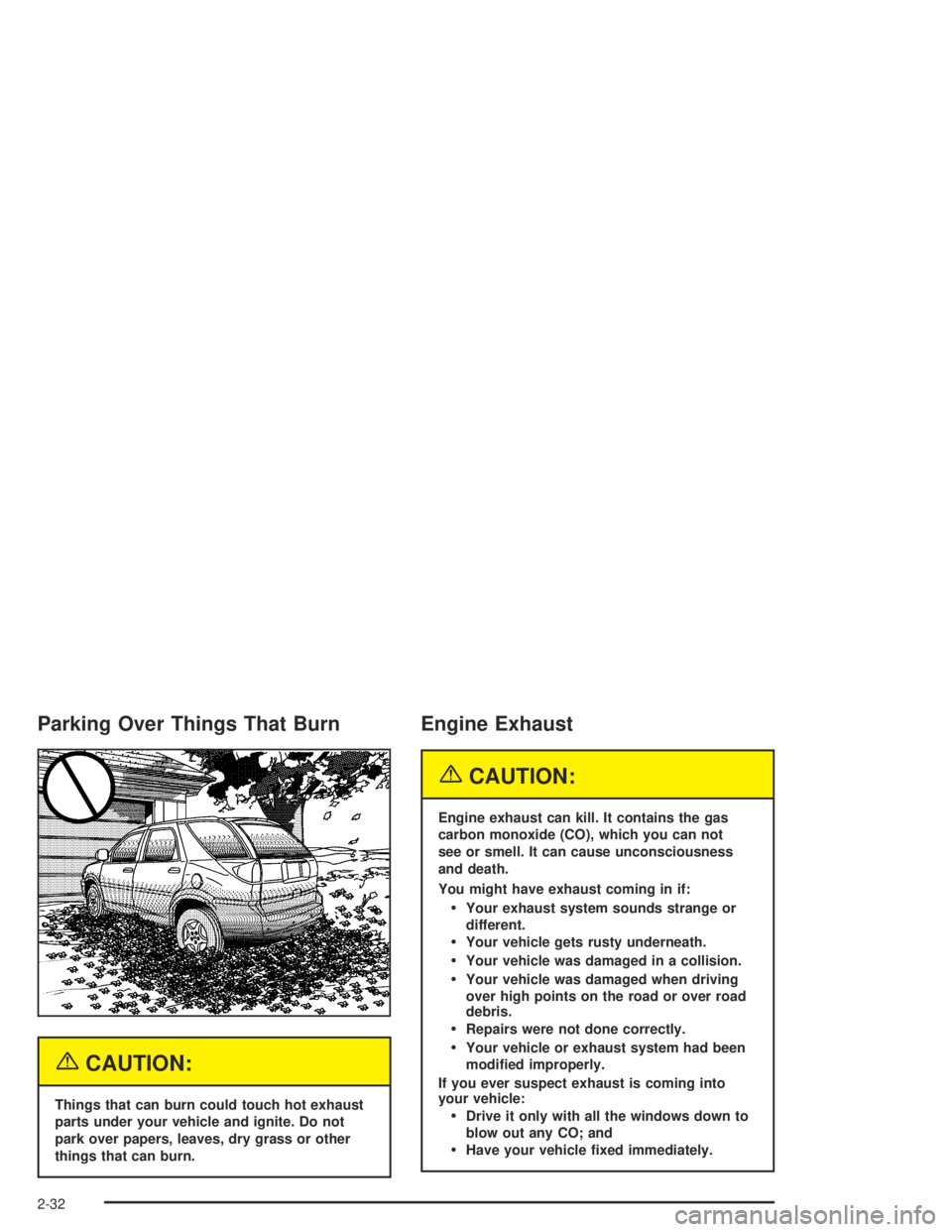
Parking Over Things That Burn
{CAUTION:
Things that can burn could touch hot exhaust
parts under your vehicle and ignite. Do not
park over papers, leaves, dry grass or other
things that can burn.
Engine Exhaust
{CAUTION:
Engine exhaust can kill. It contains the gas
carbon monoxide (CO), which you can not
see or smell. It can cause unconsciousness
and death.
You might have exhaust coming in if:
Your exhaust system sounds strange or
different.
Your vehicle gets rusty underneath.
Your vehicle was damaged in a collision.
Your vehicle was damaged when driving
over high points on the road or over road
debris.
Repairs were not done correctly.
Your vehicle or exhaust system had been
modi�ed improperly.
If you ever suspect exhaust is coming into
your vehicle:
Drive it only with all the windows down to
blow out any CO; and
Have your vehicle �xed immediately.
2-32
Page 1542 of 5127
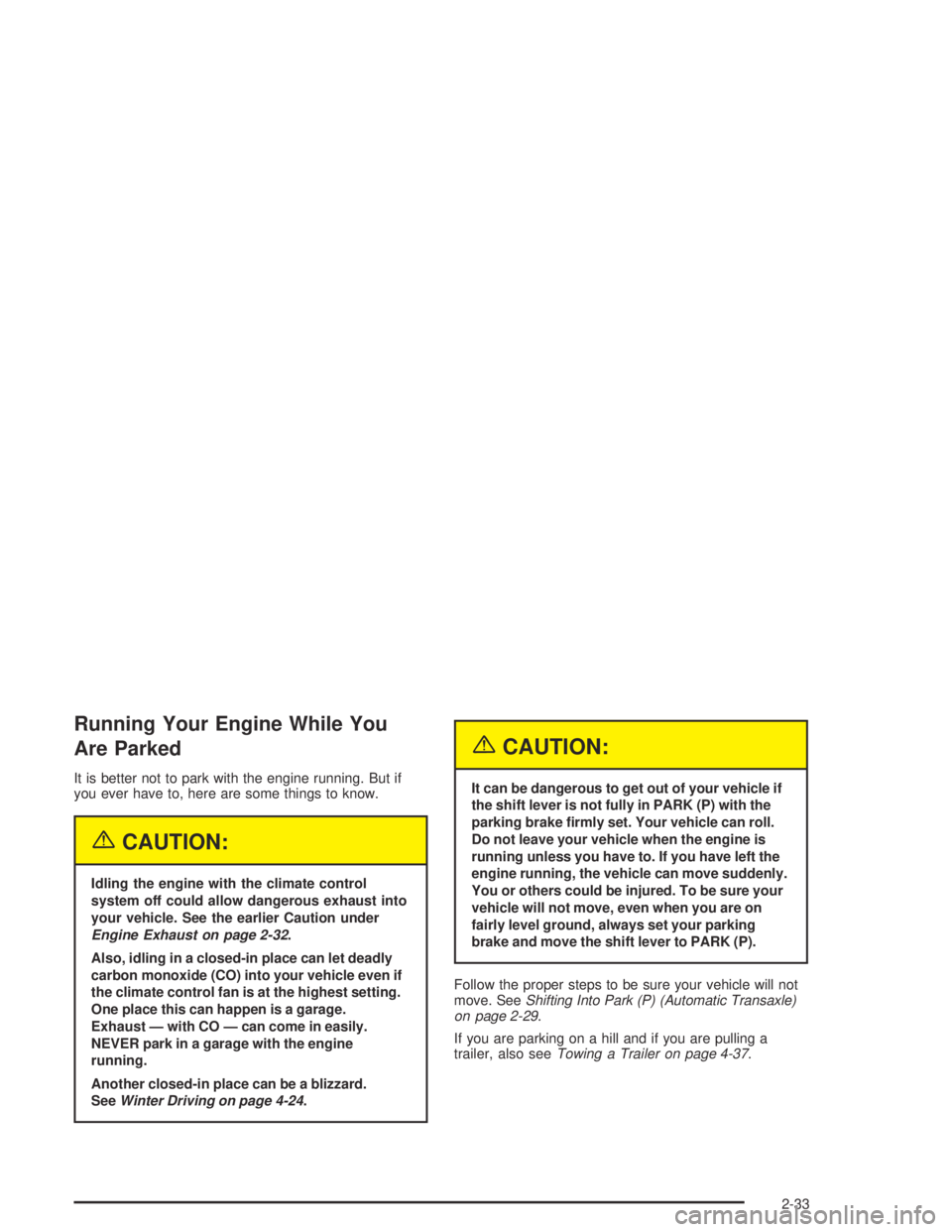
Running Your Engine While You
Are Parked
It is better not to park with the engine running. But if
you ever have to, here are some things to know.
{CAUTION:
Idling the engine with the climate control
system off could allow dangerous exhaust into
your vehicle. See the earlier Caution under
Engine Exhaust on page 2-32.
Also, idling in a closed-in place can let deadly
carbon monoxide (CO) into your vehicle even if
the climate control fan is at the highest setting.
One place this can happen is a garage.
Exhaust — with CO — can come in easily.
NEVER park in a garage with the engine
running.
Another closed-in place can be a blizzard.
SeeWinter Driving on page 4-24.
{CAUTION:
It can be dangerous to get out of your vehicle if
the shift lever is not fully in PARK (P) with the
parking brake �rmly set. Your vehicle can roll.
Do not leave your vehicle when the engine is
running unless you have to. If you have left the
engine running, the vehicle can move suddenly.
You or others could be injured. To be sure your
vehicle will not move, even when you are on
fairly level ground, always set your parking
brake and move the shift lever to PARK (P).
Follow the proper steps to be sure your vehicle will not
move. SeeShifting Into Park (P) (Automatic Transaxle)
on page 2-29.
If you are parking on a hill and if you are pulling a
trailer, also seeTowing a Trailer on page 4-37.
2-33
Page 1543 of 5127
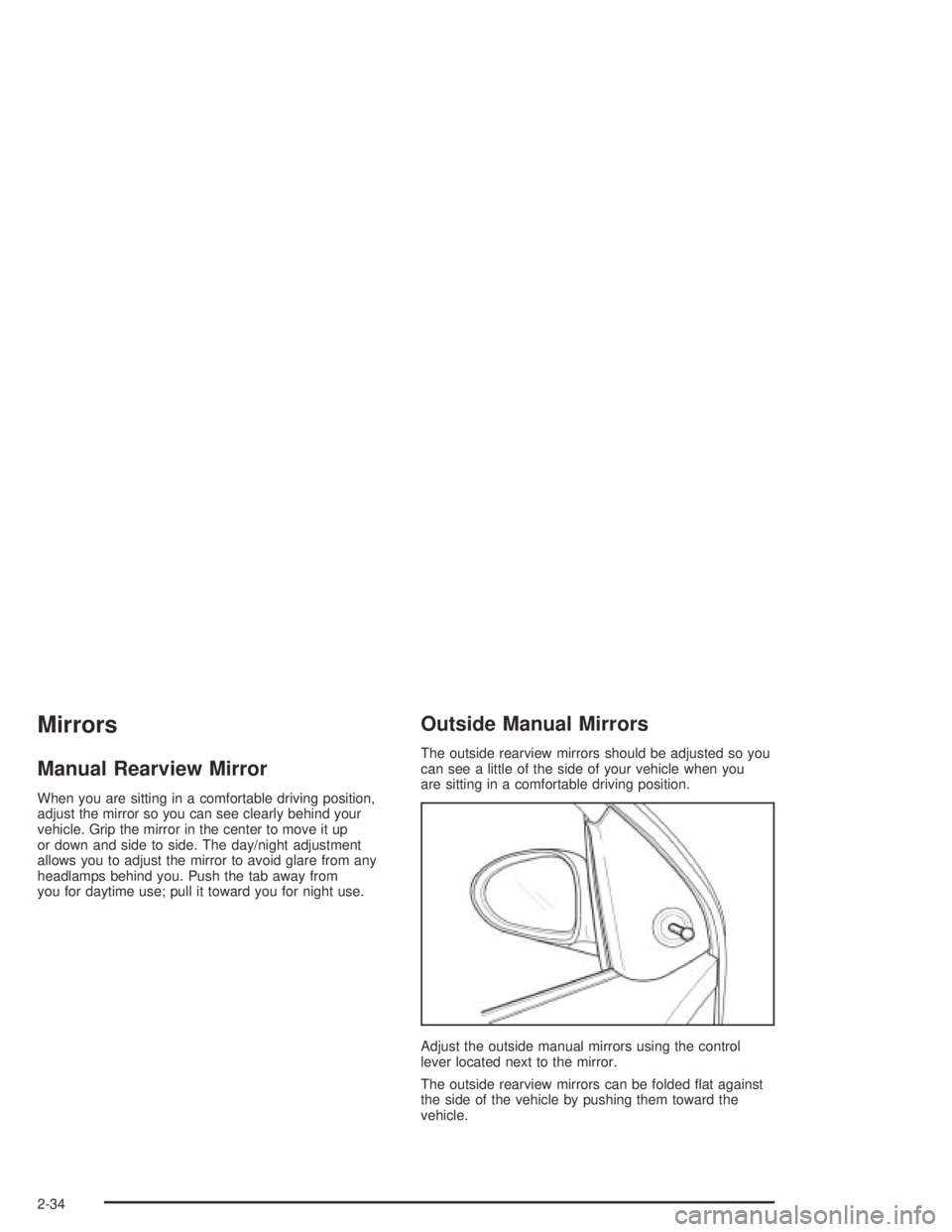
Mirrors
Manual Rearview Mirror
When you are sitting in a comfortable driving position,
adjust the mirror so you can see clearly behind your
vehicle. Grip the mirror in the center to move it up
or down and side to side. The day/night adjustment
allows you to adjust the mirror to avoid glare from any
headlamps behind you. Push the tab away from
you for daytime use; pull it toward you for night use.
Outside Manual Mirrors
The outside rearview mirrors should be adjusted so you
can see a little of the side of your vehicle when you
are sitting in a comfortable driving position.
Adjust the outside manual mirrors using the control
lever located next to the mirror.
The outside rearview mirrors can be folded flat against
the side of the vehicle by pushing them toward the
vehicle.
2-34
Page 1544 of 5127
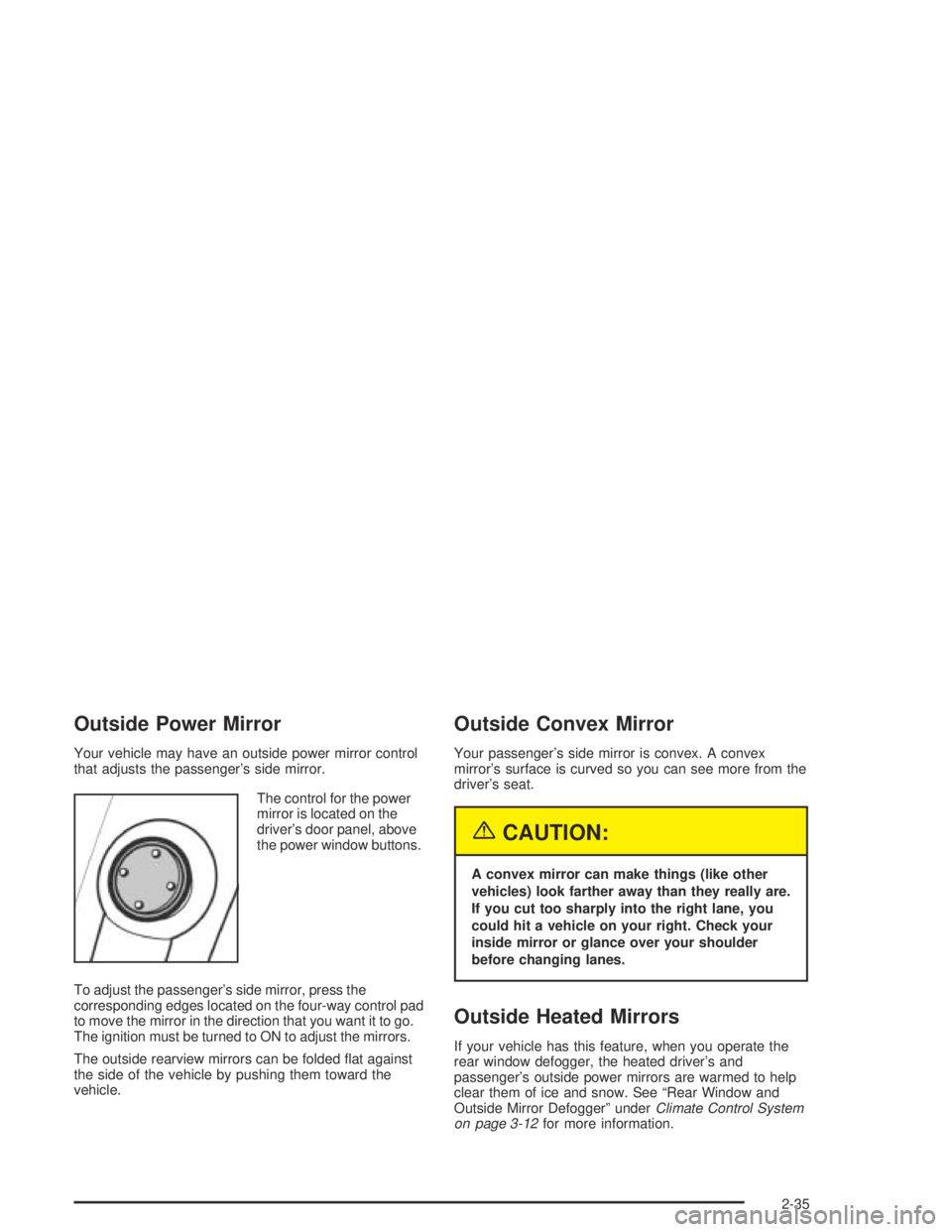
Outside Power Mirror
Your vehicle may have an outside power mirror control
that adjusts the passenger’s side mirror.
The control for the power
mirror is located on the
driver’s door panel, above
the power window buttons.
To adjust the passenger’s side mirror, press the
corresponding edges located on the four-way control pad
to move the mirror in the direction that you want it to go.
The ignition must be turned to ON to adjust the mirrors.
The outside rearview mirrors can be folded flat against
the side of the vehicle by pushing them toward the
vehicle.
Outside Convex Mirror
Your passenger’s side mirror is convex. A convex
mirror’s surface is curved so you can see more from the
driver’s seat.
{CAUTION:
A convex mirror can make things (like other
vehicles) look farther away than they really are.
If you cut too sharply into the right lane, you
could hit a vehicle on your right. Check your
inside mirror or glance over your shoulder
before changing lanes.
Outside Heated Mirrors
If your vehicle has this feature, when you operate the
rear window defogger, the heated driver’s and
passenger’s outside power mirrors are warmed to help
clear them of ice and snow. See “Rear Window and
Outside Mirror Defogger” underClimate Control System
on page 3-12for more information.
2-35
Page 1545 of 5127
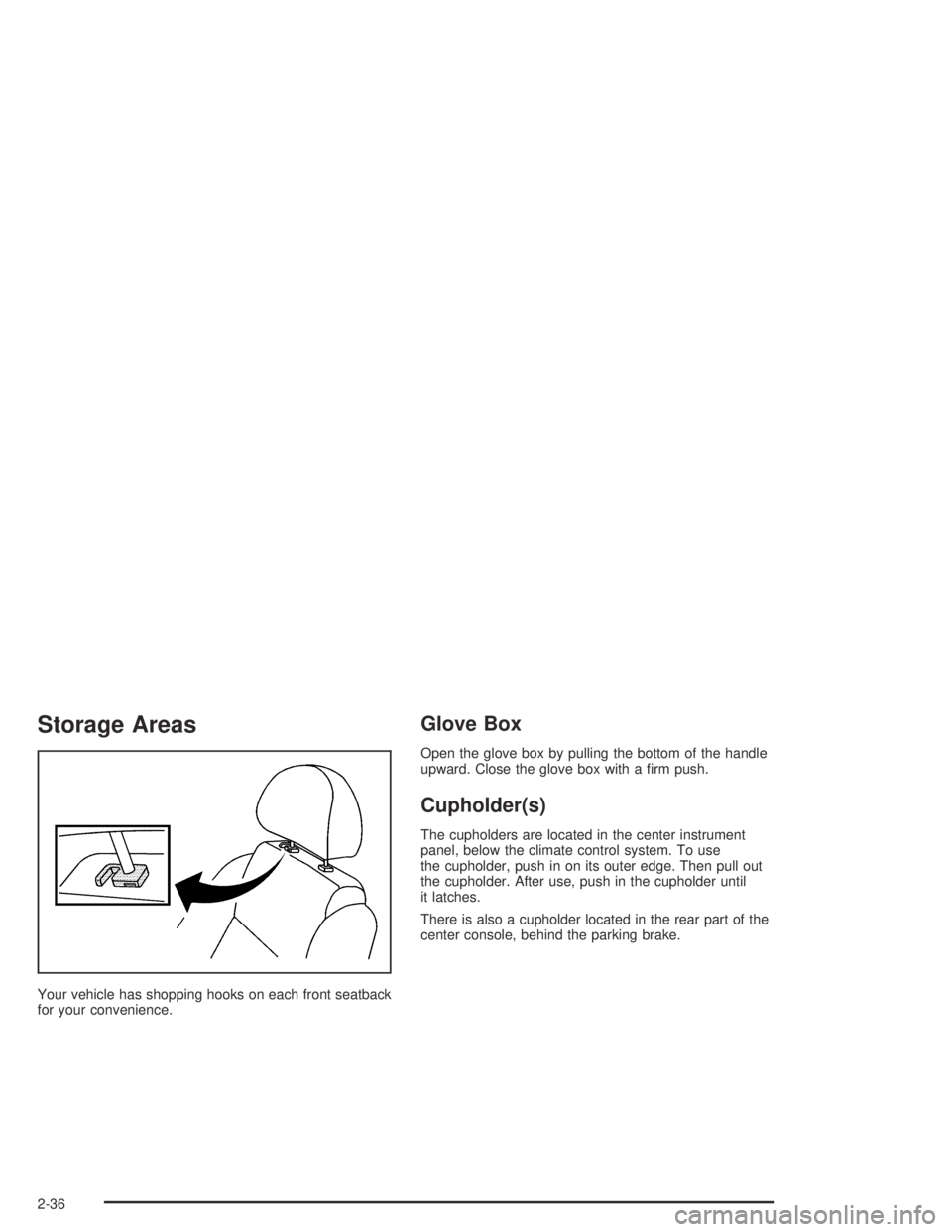
Storage Areas
Your vehicle has shopping hooks on each front seatback
for your convenience.
Glove Box
Open the glove box by pulling the bottom of the handle
upward. Close the glove box with a firm push.
Cupholder(s)
The cupholders are located in the center instrument
panel, below the climate control system. To use
the cupholder, push in on its outer edge. Then pull out
the cupholder. After use, push in the cupholder until
it latches.
There is also a cupholder located in the rear part of the
center console, behind the parking brake.
2-36
Page 1546 of 5127
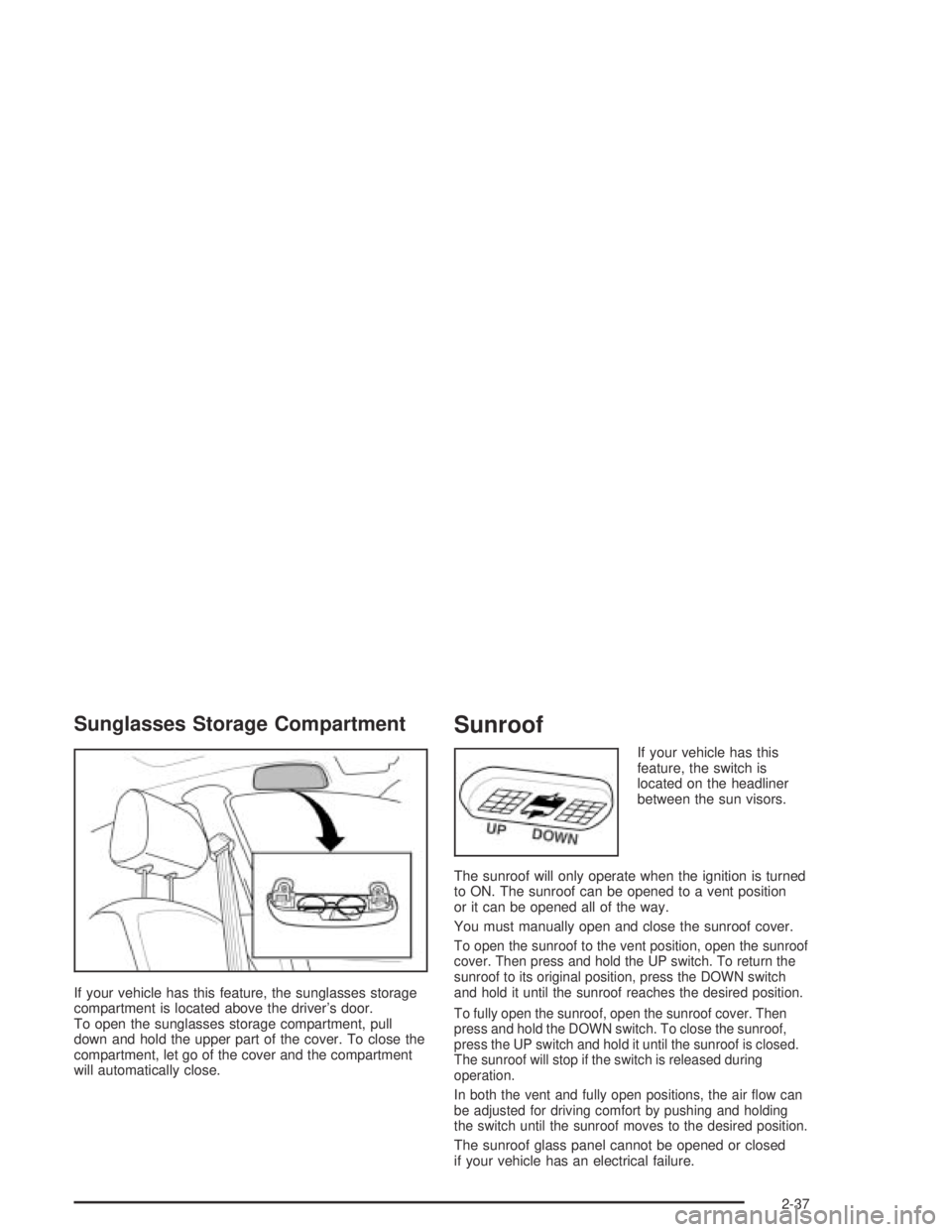
Sunglasses Storage Compartment
If your vehicle has this feature, the sunglasses storage
compartment is located above the driver’s door.
To open the sunglasses storage compartment, pull
down and hold the upper part of the cover. To close the
compartment, let go of the cover and the compartment
will automatically close.
Sunroof
If your vehicle has this
feature, the switch is
located on the headliner
between the sun visors.
The sunroof will only operate when the ignition is turned
to ON. The sunroof can be opened to a vent position
or it can be opened all of the way.
You must manually open and close the sunroof cover.
To open the sunroof to the vent position, open the sunroof
cover. Then press and hold the UP switch. To return the
sunroof to its original position, press the DOWN switch
and hold it until the sunroof reaches the desired position.
To fully open the sunroof, open the sunroof cover. Then
press and hold the DOWN switch. To close the sunroof,
press the UP switch and hold it until the sunroof is closed.
The sunroof will stop if the switch is released during
operation.
In both the vent and fully open positions, the air flow can
be adjusted for driving comfort by pushing and holding
the switch until the sunroof moves to the desired position.
The sunroof glass panel cannot be opened or closed
if your vehicle has an electrical failure.
2-37
Page 1547 of 5127

✍NOTES
2-38
Page 1548 of 5127
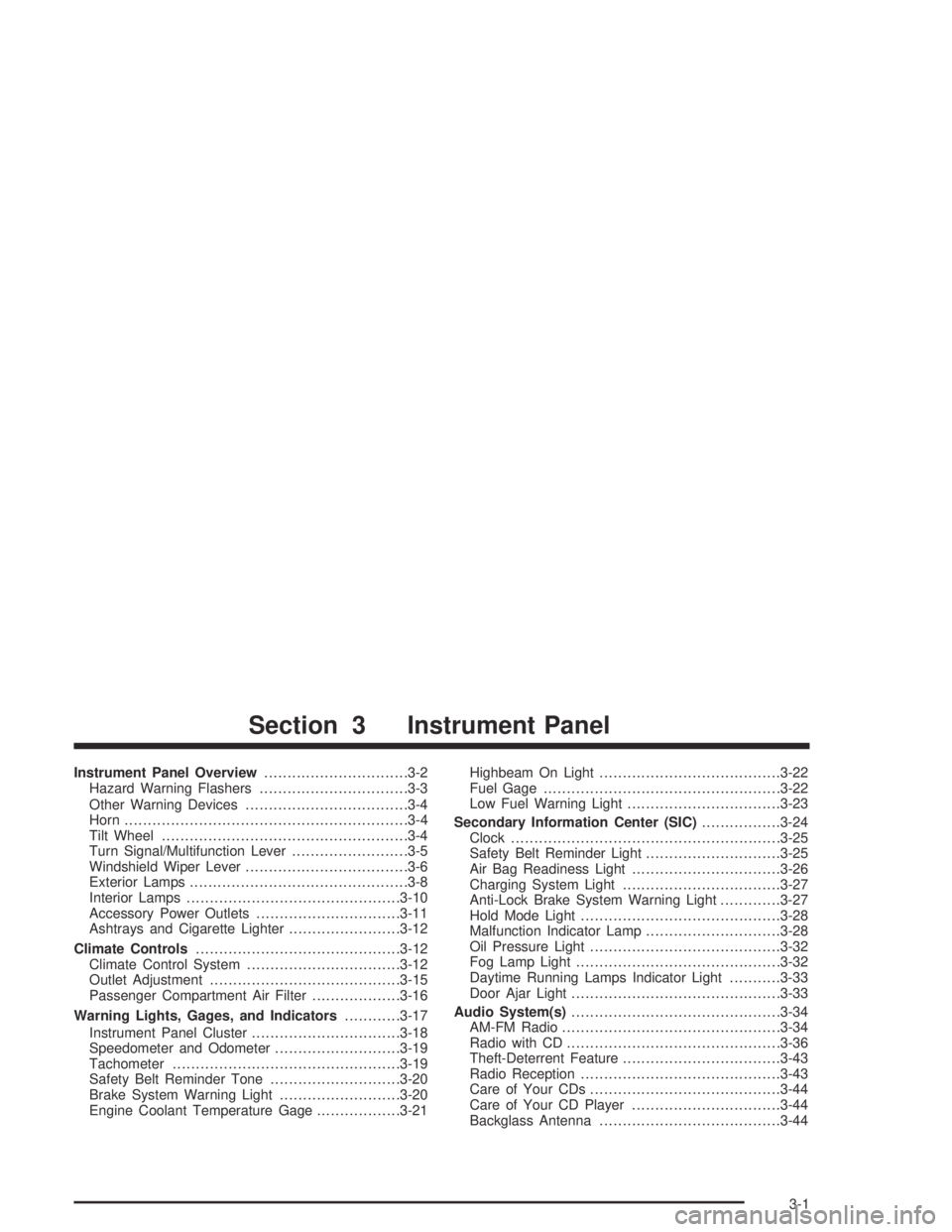
Instrument Panel Overview...............................3-2
Hazard Warning Flashers................................3-3
Other Warning Devices...................................3-4
Horn.............................................................3-4
Tilt Wheel.....................................................3-4
Turn Signal/Multifunction Lever.........................3-5
Windshield Wiper Lever...................................3-6
Exterior Lamps...............................................3-8
Interior Lamps..............................................3-10
Accessory Power Outlets...............................3-11
Ashtrays and Cigarette Lighter........................3-12
Climate Controls............................................3-12
Climate Control System.................................3-12
Outlet Adjustment.........................................3-15
Passenger Compartment Air Filter...................3-16
Warning Lights, Gages, and Indicators............3-17
Instrument Panel Cluster................................3-18
Speedometer and Odometer...........................3-19
Tachometer.................................................3-19
Safety Belt Reminder Tone............................3-20
Brake System Warning Light..........................3-20
Engine Coolant Temperature Gage..................3-21Highbeam On Light.......................................3-22
Fuel Gage...................................................3-22
Low Fuel Warning Light.................................3-23
Secondary Information Center (SIC).................3-24
Clock..........................................................3-25
Safety Belt Reminder Light.............................3-25
Air Bag Readiness Light................................3-26
Charging System Light..................................3-27
Anti-Lock Brake System Warning Light.............3-27
Hold Mode Light...........................................3-28
Malfunction Indicator Lamp.............................3-28
Oil Pressure Light.........................................3-32
Fog Lamp Light............................................3-32
Daytime Running Lamps Indicator Light...........3-33
Door Ajar Light.............................................3-33
Audio System(s).............................................3-34
AM-FM Radio...............................................3-34
Radio with CD..............................................3-36
Theft-Deterrent Feature..................................3-43
Radio Reception...........................................3-43
Care of Your CDs.........................................3-44
Care of Your CD Player................................3-44
Backglass Antenna.......................................3-44
Section 3 Instrument Panel
3-1
Page 1549 of 5127
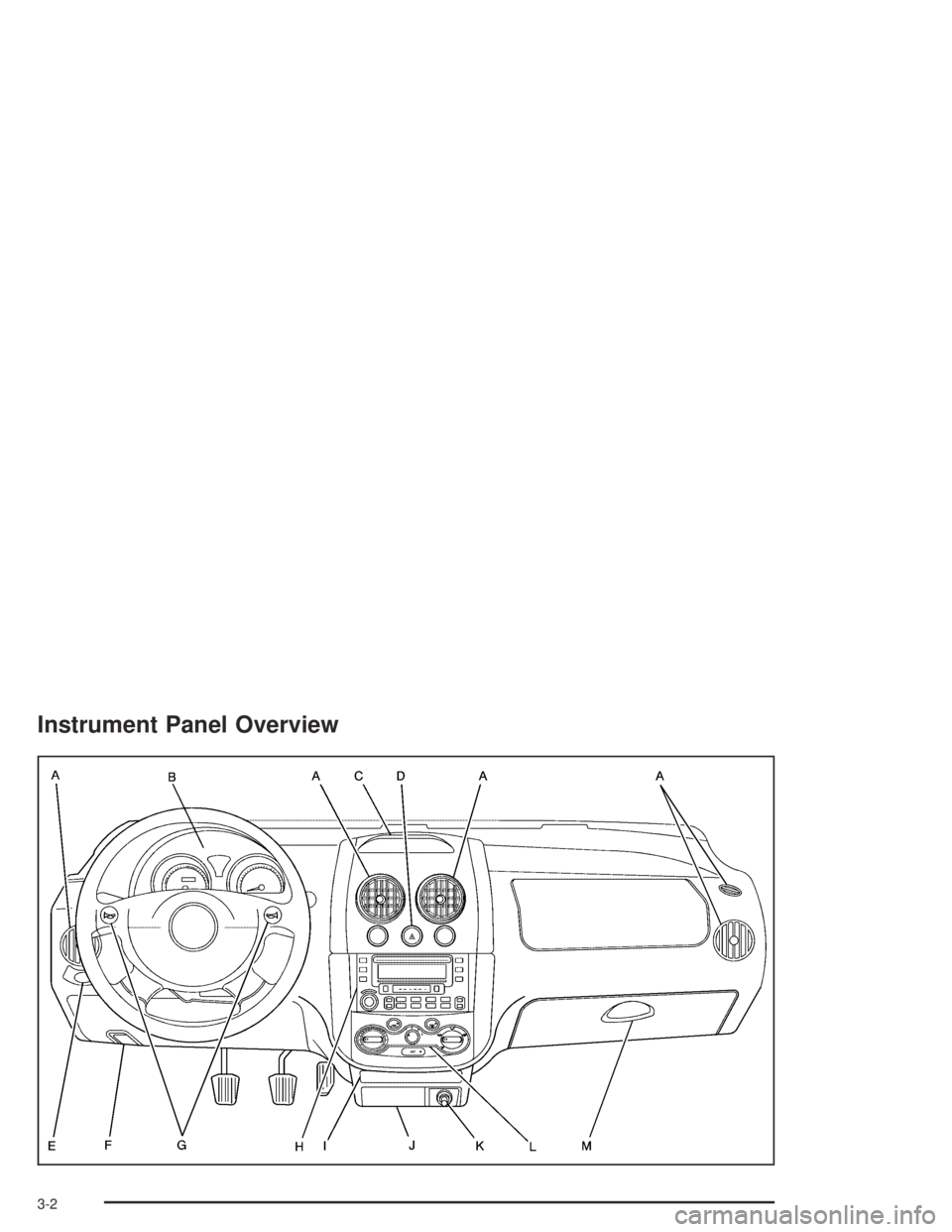
Instrument Panel Overview
3-2
Page 1550 of 5127
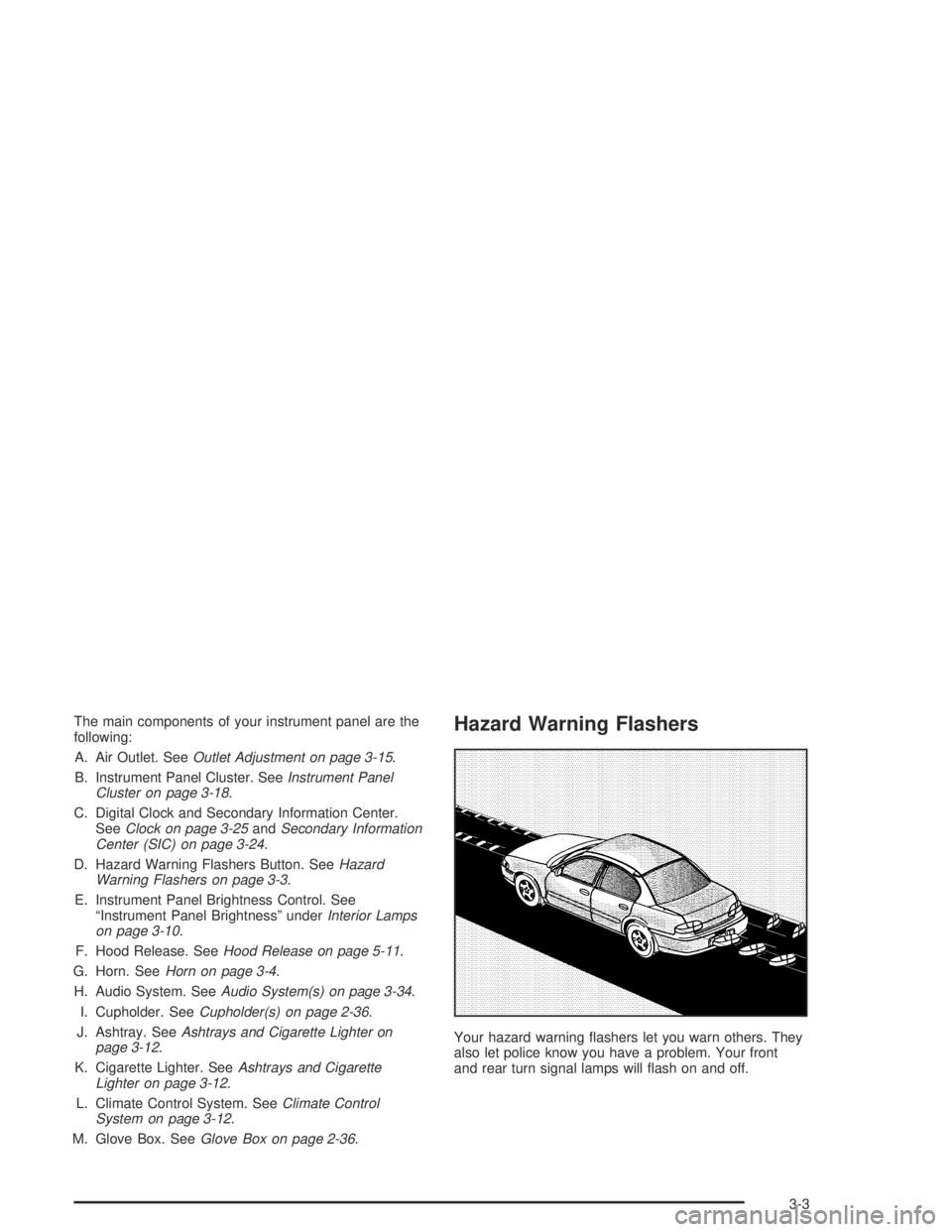
The main components of your instrument panel are the
following:
A. Air Outlet. SeeOutlet Adjustment on page 3-15.
B. Instrument Panel Cluster. SeeInstrument Panel
Cluster on page 3-18.
C. Digital Clock and Secondary Information Center.
SeeClock on page 3-25andSecondary Information
Center (SIC) on page 3-24.
D. Hazard Warning Flashers Button. SeeHazard
Warning Flashers on page 3-3.
E. Instrument Panel Brightness Control. See
“Instrument Panel Brightness” underInterior Lamps
on page 3-10.
F. Hood Release. SeeHood Release on page 5-11.
G. Horn. SeeHorn on page 3-4.
H. Audio System. SeeAudio System(s) on page 3-34.
I. Cupholder. SeeCupholder(s) on page 2-36.
J. Ashtray. SeeAshtrays and Cigarette Lighter on
page 3-12.
K. Cigarette Lighter. SeeAshtrays and Cigarette
Lighter on page 3-12.
L. Climate Control System. SeeClimate Control
System on page 3-12.
M. Glove Box. SeeGlove Box on page 2-36.Hazard Warning Flashers
Your hazard warning flashers let you warn others. They
also let police know you have a problem. Your front
and rear turn signal lamps will flash on and off.
3-3